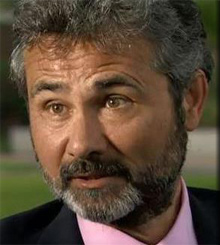US Pensions
THIS ARCHIVE PAGE IS UPDATED ONLY TO 2004
Since US pension funds, like the UK, hold a high percentage of equities, they were hit hard by stock market falls in 2001 and 2002. The New York Times's March 2003 article "Arguing against equities" is aimed at private investors, but draws obvious lessons for pension funds. Ryan Labs produces regular market-based valuations of US pension assets and liabilities.
For the US stock market as a whole, John Plender comments on the Brookings Paper "Did higher stock prices cause stock prices to rise?". This concludes empirically what we knew anecdotally -pension surpluses caused by the 1990's bull market fuelled the stock market still further.
The UBS team produced a good S&P 500 review in September 2002.
I can only scratch the surface of the many articles about individual US companies IBM (December 2002) and GM (January 2003), as well as New York City in the public sector. US companies have also gone bust with big pension deficits cited as major factors in their demise - Bethlehem Steel had a $1.9bn deficit when it filed for Chapter 11 in October 2001.
Although the US has not had FRS 17 to fuel its pensions debate, the inadequacies of pension accounting have received much coverage, particularly the "expected return on assets" in the P & L. Philip Coggan wrote "On the edge of a credibility gap" in September 2002 and the FT also had "A forest clearing" and "US pensions train risks running out of gravy". With increased co-operation between the FASB & the IASB the September 2002 FT headline was "US prepare for revolution in accounting standards".
All the academic corporate finance and pensions work is US, based on original work by US financial economists in the late 1970s and early 1980s, including Fischer Black, Bill Sharpe, Irwin Tepper and Jack Treynor. The seminal article on company pension funding is by Fisher Black, "The tax consequences of long-run pension policy" in 1980.
Zvi Bodie is one of the best missionaries. As well as his academic articles, such as "On the risk of stocks in the long run" - he is a great populariser and teacher (I have seen him in action doing both) "Longer time horizon does not reduce risk" January 2002) and "Long view turns out to be risky business". (April 2002)
The US Actuarial Profession held a symposium on "The Great Controversy: Current Pension Actuarial Practice in Light of Financial Economics", with papers from several UK actuaries, including Cliff Speed, Jon Palin and me.
US pension regulation is governed by ERISA ("Employee Retirement Income Security Act") legislation in place since 1974. This also set up the PBGC ("Pension Benefit Guaranty Corporation") to insure pensions, which is backed by the Federal Government.
The wider implications for the US economy of the implicit Government guarantee of the PBGC are discussed in the Wall Street Journal Europe and The Economist , both May 2002. Two Economist articles from early 2003 also discuss the economics of the PBGC "Broke" and the discount rate which should be used to value liabilities.
They both quote Zvi Bodie whose contribution to understanding the risks of the PBGC dates back a long way. "What the PBGC can learn from the FSLIC" (1996) and with the Nobel Laureate, Robert Merton on "The Management of Financial Guarantees" (1992) & "Pension Benefit Guarantees in the US" (1993).
Also read Bodie, Merton and Robert Kaplan's March 2003 article in Harvard Business Review on a related topic "For the Last Time: Stock options are an Expense."
US actuaries have tended to be less influenced by financial economics than UK actuaries, partly as a result of the rules-focused approach encouraged by the 1974 ERISA legislation. There are some US actuaries thinking along market lines. Jeremy Gold published "Accounting/ Actuarial Bias Enables Equity Investment by Defined Benefit Pension Plans" in May 2000 and, along with Larry Bader, "Reinventing Pension Actuarial Science" discussing the "ossification" of US pensions thinking caused by ERISA. See also Larry Bader?s May 2003 article in The Financial Analyst's Journal.
JER ARTICLES

"Ford is right to match its pension assets and liabilities"
FT A-List blog Co-written with
Zvi Bodie February 2012
"Pension pothole on GM's road to recovery"
FTfm June 2009
"US pension body's shift over equities adds insult to injury"
FT Letter co-written with Zvi Bodie February 2008
"GM "profits" from boosting its pension fund"
The Times January 2004



